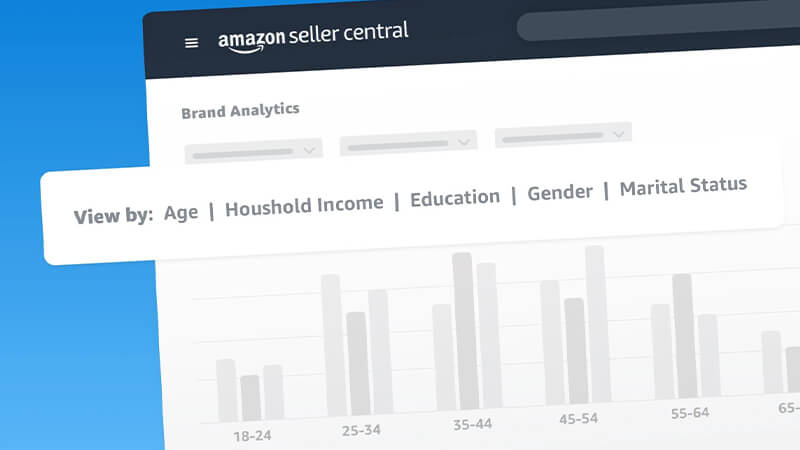Amazon stands tall as the unrivalled giant in the fast-paced world of e-commerce, where success is measured by conversions and customer satisfaction. With millions of sellers vying for attention and an ever-growing customer base, the competition is fierce. Merely listing products on Amazon and hoping for the best won’t cut it anymore. To truly thrive in this marketplace, sellers need to arm themselves with valuable insights and data-driven strategies. That’s where Amazon Brand Analytics comes into play.
Amazon Brand Analytics is a robust suite of tools that empowers sellers to make informed decisions, and gain a competitive edge. This suite provides a treasure trove of data and insights into customer behaviour, market trends, and competitor analysis. Armed with this information, sellers can refine their strategies, enhance their brand presence, and drive sales. Whether you’re a seasoned seller looking to fine-tune your strategies or a budding entrepreneur stepping into the world of e-commerce, Amazon Brand Analytics holds the key to your success. Let’s discover how you can leverage its capabilities to outshine the competition and establish a successful brand on Amazon.
Understanding Amazon Brand Analytics
Amazon Brand Analytics is a game-changer for sellers on the Amazon platform. It is important to grasp the purpose and significance of Amazon Brand Analytics to comprehend its real impact. The suite of tools goes beyond surface-level metrics and provides a comprehensive understanding of customer behaviour and market dynamics. At its core, Amazon Brand Analytics is a collection of data-driven tools that helps sellers in granular customer analysis, product listing optimization, and beyond. It provides valuable insights and empowers brands to make informed decisions that drive sales and growth.
Let’s explore the key components that makeup Amazon Brand Analytics and how they contribute to a seller’s success.
Key features of Amazon Brand Analytics
- Amazon search terms report: The Amazon search terms report is a vital tool within Amazon Brand Analytics that provides sellers with valuable keyword insights. It reveals the specific search terms customers use to discover products similar to theirs. By analysing this report, sellers can gain a deep understanding of the keywords that are driving traffic and conversions. Armed with this information, sellers can optimise their product listings by incorporating relevant keywords, enhancing the relevance of their listings, and increasing visibility in search results. By aligning their listings with customer search queries, sellers can attract more potential buyers and improve their overall search rankings.
- Item comparison and alternate purchase behaviour: This feature within Amazon Brand Analytics allows sellers to identify the products that customers compare with their offerings and the products that customers ultimately choose to purchase instead. By understanding consumer preferences and identifying competitors, sellers can refine their marketing strategies and product offerings. This knowledge enables sellers to address any gaps or shortcomings in their products and differentiate themselves from the competition. For example, if customers frequently compare a competitor’s product with yours and end up choosing the competitor’s product, you can analyse the reasons behind their choice and make necessary improvements or adjustments to your own product to better meet customer expectations and preferences.
- Market basket analysis: Market basket analysis is a powerful feature that uncovers the relationship between products frequently purchased together. By analysing the purchasing patterns of customers, sellers can identify product combinations that are commonly bought together. This information opens up opportunities for cross-selling and upselling. Sellers can create product bundles or recommend complementary items to customers, increasing the average order value and maximising revenue. For example, if customers frequently purchase a particular camera along with a camera lens, sellers can create a bundle offer that includes both items at a discounted price, enticing customers to buy both together and increasing sales.
- Demographics report: Understanding the demographics of your customer base is essential for effective marketing and personalised targeting. The Demographics feature within Amazon Brand Analytics provides valuable insights into the age, gender, income levels, and other demographic characteristics of your customers. This information enables sellers to tailor their marketing messages and campaigns to resonate with their target market. For example, if the data shows that a significant portion of your customer base consists of young adults, you can create marketing content that appeals to this specific demographic. The report visually represents the geographical distribution of your customers, helping you understand where your products are most popular and enabling you to optimise your marketing efforts in those regions.
Utilising Amazon Brand Analytics for success
To truly harness the power of Amazon Brand Analytics, sellers need to leverage the insights and data provided by the platform to drive success. Here are some key strategies for utilizing Amazon Brand Analytics to achieve your goals:
- Refining product listings: One of the primary benefits of Amazon Brand Analytics is the ability` to refine your product listings for maximum visibility and conversion. By analysing the Search Terms Report, you can identify the keywords that customers use to discover products similar to yours. Incorporating these relevant keywords in your product listings increases the chances of your products appearing in relevant search results. Additionally, the item comparison and alternate purchase behaviour features help you understand why customers may be choosing competitors’ products over yours. By addressing any gaps or shortcomings in your offerings, you can differentiate yourself from the competition and improve your chances of winning customer preference.
- Enhancing marketing strategies: Market basket analysis is a valuable feature within Amazon Brand Analytics that reveals customer preferences and purchase patterns. By analysing the relationships between products frequently purchased together, you can identify cross-selling opportunities and create targeted marketing campaigns. For example, if customers frequently buy a specific type of camera along with camera lenses, you can create bundles that offer both items at a discounted price. This not only increases the average order value but also encourages customers to purchase complementary items together. Additionally, by understanding customer demographics, you can tailor your marketing messages and campaigns to resonate with specific target audiences, resulting in more effective and personalised promotions.
- Leveraging Amazon Brand Analytics for advertising: Integrating Amazon Brand Analytics with your sponsored advertising campaigns allows you to access valuable insights that can optimise your ad targeting and maximise your return on investment. By analysing customer search terms and understanding the keywords that drive conversions, you can refine your ad targeting and ensure that your ads are reaching the right audience. This data-driven approach increases the visibility of your products, improves the performance of your ads, and ultimately drives higher sales.
- A+ Content and storefront optimisation: The demographics data and heat map feature within Amazon Brand Analytics provide valuable information about the geographical distribution of your customer base. This information can be used to optimize your Amazon A Plus Content and storefront design. By tailoring your content and storefront to resonate with specific regions or demographics, you can create a more personalised and engaging shopping experience for your target audience. This, in turn, increases customer trust and loyalty, leading to improved conversion rates and long-term success.
- Staying ahead of the competition: With Amazon Brand Analytics, you gain valuable insights into your competitors’ products and their customers’ buying behaviour. By monitoring your competitors, you can identify emerging trends, understand customer preferences, and adjust your strategies accordingly. This helps you stay ahead of the competition and capture a larger market share. For example, if you notice a particular product feature gaining popularity among customers, you can incorporate similar features in your own products to meet the evolving demands of the market.
By using Amazon Brand Analytics for advertising optimisation, you can ensure that your Amazon sponsored ads are effectively reaching your target audience, while optimized A+ Content and Amazon storefront design create a compelling brand experience. This comprehensive approach maximises the impact of your advertising efforts and helps you stand out in the competitive Amazon marketplace.
Final thoughts
Amazon Brand Analytics is a powerful tool that empowers sellers to make informed decisions, enhance their presence on Amazon, and achieve long-term success. By adopting a data-driven approach and leveraging the suite of tools offered, businesses can unlock their full potential and thrive in the dynamic Amazon landscape. So, take advantage of Amazon Brand Analytics and position your brand for success in the ever-evolving world of online retail. You can also seek guidance and proven support from our Amazon consulting experts in utilising this tool and achieving your goal of increased sales and higher returns.






About The Author
Jimi Patel
Jimi Patel, is a Co-founder and CEO at eStore Factory, an Amazon SPN certified agency that serves as a one-stop solution for all your Amazon business needs. Having helped countless brands increase sales and grow their footprint on Amazon, Jimi provides the most practical and effective solutions for your business. He is highly skilled in developing and executing plans that align with your specific business goals and objectives. When not working, Jimi enjoys practicing yoga and traveling to new places. He is an avid reader and enjoys staying up-to-date on the latest trends and developments in the e-commerce industry.